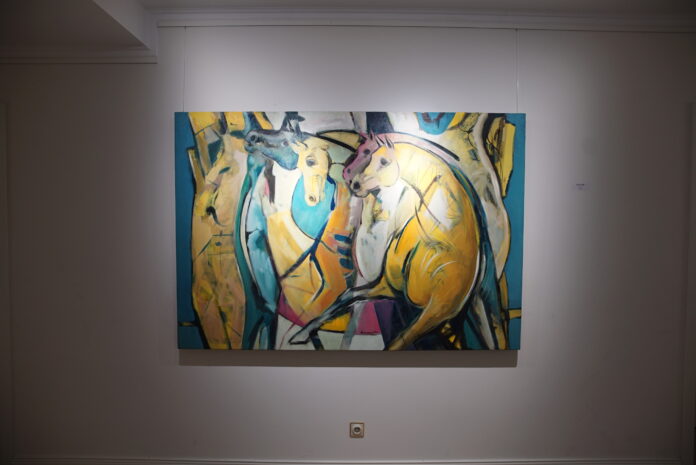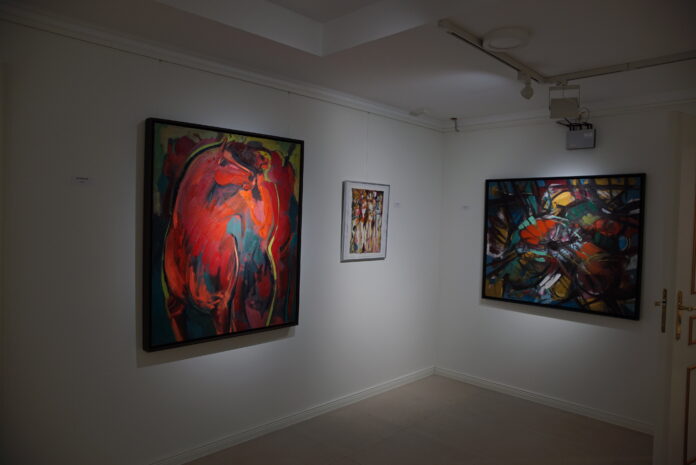The Divan – The Arabic Cultural House, in collaboration with the Embassy of Lebanon in Germany, opened the exhibition “Circle of Life” featuring renowned artists, the Lebanese-Italian Giorgia Fonnesu and Lebanese Emmanuel Guiragossian. The exhibition will be on view at the Arabic Culture House from 1 July to 30 July 2023. The vernissage thereto took place on Friday, 30 June. Both the Ambassador of Lebanon in Germany, Dr. Mustapha Adib, Doyen of the Arab Diplomatic Corps and the Secretary-General of The Divan, Asma Al Bakr welcomed the invited guests.
Emmanuel Guiragossian is one of Lebanon’s most significant contemporary artists and one of the most sought-after artists in the international art scene. He was born in Lebanon in 1954 as the eldest son of the legendary painter Paul Guiragossian (1926-1993). His paternal grandparents were survivors of the Armenian genocide during the First World War. Their experiences, along with his grandmother’s accounts of the horrifying events of their survival and their experiences during two world wars and civil wars, had a profound impact on the young Emmanuel. His painting talent emerged early. After receiving a scholarship to study at the Dresden Art Academy (1974 – 1979), his international career began. He has been a professor since 1984 at the Académie libanese des beaux- arts (ALBA) and the American University (AUB) in Beirut, despite the difficult situation due to the Lebanese Civil War (1975- 1990) that occurred during these years.
Emmanuel Guiragossian is a master in the depiction of the human figure and animals. In many of his paintings, humans are central, not as individuals but in groups. It is characteristic that many people stand together, closely together, leaning on each other, intertwined. These are abstract compositions of woven human figures that symbolize the collective nature of humanity. In the 1980s, the horse became a subject in his work. In many pieces, the horse is central, such as in the “Circle of Life” painting that can be seen in the Divan.
Exhibitions have taken place in countries such as Lebanon, Germany, Canada, the USA, the United Arab Emirates, and Jordan. Beyond focusing on his own artistic career, he closely worked with his father, Paul Guiragossian. In 1991, the EMMAGOSS Art Gallery was founded in Lebanon in partnership with his father and with the support of his family. In 2007, the gallery expanded with the opening of a second location in Dresden.

Emmanuel lives between Beirut, Dresden, and Berlin. In Berlin, he maintains a studio where he regularly stays for extended periods.
The second exhibition at the Divan – The Arabic Cultural House features the Italian – Lebanese artist Giorgia Fonnesu, who creates objects and sculptures out of clay. Giorgia, born in 1974, grew up on the shores of the Mediterranean between Lebanon and Sardinia.
“The sea has always surrounded my life, furthermore, the Mediterranean influenced my way of thinking, especially when I noticed the great connection between my homeland Sardinia and Lebanon,” says Giorgia. From an early age, she was fascinated by sea urchins, not just because of their appearance, but also because of the significance they hold. “Sea urchins,” she says, “are seen as guardians of the marine ecosystem. That interested me.” Her installation shown at the Divan refers to the importance of sea urchins and their role in climate change.
For the conception of the exhibition, the Arabic Cultural House has enlisted the internationally renowned art historian and curator Karin Adrian von Roques. During her studies of Islamic Art History, she specialized in contemporary art from the Middle East and North Africa (MENA) in the 1990s. For more than 20 years, she has curated exhibitions worldwide in museums and cultural institutions. She has particularly witnessed the changes in the Gulf states, such as Qatar, and how they have affected the art scene.

For The Divan – The Arabic Cultural House, it is part of the program to address current and controversial topics, such as the thematic complex of women planned for the beginning of 2023, and for the future, the topics of nature, environmental problems, and sustainability. For this purpose, various events are designed and displayed, ranging from panel discussions to lectures or readings and art exhibitions.
The Arabic Cultural House is convinced that art can particularly change the way we think. The vision of the Arab Culture House is not only to bridge the gap between German and Arab culture but also to build a bridge between nations and cultures internationally, as in this exhibition between Qatar, Germany, Lebanon, and Italy.
For further information



